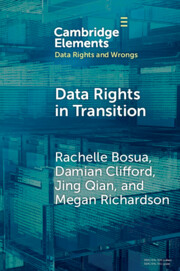Refine search
Actions for selected content:
302 results

Data Rights in Transition
-
- Published online:
- 08 August 2025
- Print publication:
- 04 September 2025
-
- Element
-
- You have access
- HTML
- Export citation
15 - Generative AI and Data Protection
- from Part III - Generative AI
-
-
- Book:
- The Cambridge Handbook of Generative AI and the Law
- Published online:
- 08 August 2025
- Print publication:
- 07 August 2025, pp 237-254
-
- Chapter
- Export citation
18 - A Professional Wrestler, Privacy, and the Meaning of News
- from Part V - Identifying Performers of the Press Function
-
-
- Book:
- The Future of Press Freedom
- Published online:
- 25 July 2025
- Print publication:
- 24 July 2025, pp 298-308
-
- Chapter
-
- You have access
- Open access
- HTML
- Export citation
11 - Money and Freedom
-
- Book:
- Money In Crisis
- Published online:
- 15 July 2025
- Print publication:
- 12 June 2025, pp 289-303
-
- Chapter
- Export citation
5 - The Paradox of Cash
-
- Book:
- Money In Crisis
- Published online:
- 15 July 2025
- Print publication:
- 12 June 2025, pp 105-132
-
- Chapter
- Export citation
8 - Jewish Experiences of Segregation and Ghettoization
-
-
- Book:
- The Cambridge History of the Holocaust
- Published online:
- 16 May 2025
- Print publication:
- 12 June 2025, pp 132-146
-
- Chapter
- Export citation
The Beehive’s Poison: Analysing Legal and Ethical Dilemmas Encircling Evidence Gathered from Sting Operations in India
-
- Journal:
- International Annals of Criminology , First View
- Published online by Cambridge University Press:
- 25 April 2025, pp. 1-17
-
- Article
- Export citation
6 - Public Sector Privacy and Data Protection
- from Part II - Legal Controls
-
- Book:
- Combatting the Code
- Published online:
- 26 March 2025
- Print publication:
- 03 April 2025, pp 96-127
-
- Chapter
- Export citation
13 - Privatizing the Creation of Equity in Women’s Health
- from Part III - Russian Dolls, Reproduction, and Private Law
-
-
- Book:
- Health Law as Private Law
- Published online:
- 16 March 2025
- Print publication:
- 27 March 2025, pp 162-174
-
- Chapter
-
- You have access
- Open access
- HTML
- Export citation
8 - EU Competition Law and Personalized Pricing
- from Part II - EU Law Perspectives on Price Personalization
-
-
- Book:
- The Cambridge Handbook of Algorithmic Price Personalization and the Law
- Published online:
- 20 March 2025
- Print publication:
- 27 March 2025, pp 192-216
-
- Chapter
- Export citation
9 - Personalized Pricing in Brazil
- from Part III - Beyond the European Union
-
-
- Book:
- The Cambridge Handbook of Algorithmic Price Personalization and the Law
- Published online:
- 20 March 2025
- Print publication:
- 27 March 2025, pp 219-236
-
- Chapter
- Export citation
12 - Price Personalization
- from Part III - Beyond the European Union
-
-
- Book:
- The Cambridge Handbook of Algorithmic Price Personalization and the Law
- Published online:
- 20 March 2025
- Print publication:
- 27 March 2025, pp 284-299
-
- Chapter
- Export citation
10 - The (Il)legality of Algorithmic Personalized Pricing
- from Part III - Beyond the European Union
-
-
- Book:
- The Cambridge Handbook of Algorithmic Price Personalization and the Law
- Published online:
- 20 March 2025
- Print publication:
- 27 March 2025, pp 237-269
-
- Chapter
- Export citation
5 - Common Nonsense about Password Security and the Expert–Layperson Knowledge Gap
-
-
- Book:
- Governing Misinformation in Everyday Knowledge Commons
- Published online:
- 13 March 2025
- Print publication:
- 20 March 2025, pp 94-122
-
- Chapter
-
- You have access
- Open access
- HTML
- Export citation
Expanding the paradigm: Generative artificial intelligence and U.S. privacy norms
- Part of
-
- Journal:
- Cambridge Forum on AI: Law and Governance / Volume 1 / 2025
- Published online by Cambridge University Press:
- 07 March 2025, e16
-
- Article
-
- You have access
- Open access
- HTML
- Export citation
Can privacy be diminished by falsehoods?
-
- Journal:
- Episteme , First View
- Published online by Cambridge University Press:
- 26 February 2025, pp. 1-21
-
- Article
-
- You have access
- Open access
- HTML
- Export citation
7 - AI Meets the GDPR
- from Part II - AI, Law and Policy
-
-
- Book:
- The Cambridge Handbook of the Law, Ethics and Policy of Artificial Intelligence
- Published online:
- 06 February 2025
- Print publication:
- 13 February 2025, pp 133-157
-
- Chapter
-
- You have access
- Open access
- HTML
- Export citation
Chapter 14 - Tasteful Sketches and Tasteless Ambition
-
-
- Book:
- The New Nineteenth-Century American Literary Studies
- Published online:
- 02 January 2025
- Print publication:
- 23 January 2025, pp 203-215
-
- Chapter
- Export citation
4 - An Overview of the ISO 18000-63 Standard
-
- Book:
- Radio Frequency Identification Engineering
- Published online:
- 02 January 2025
- Print publication:
- 09 January 2025, pp 77-92
-
- Chapter
- Export citation
The new goals of EU competition law: sustainability, labour rights, and privacy
-
- Journal:
- European Law Open / Volume 3 / Issue 3 / September 2024
- Published online by Cambridge University Press:
- 09 January 2025, pp. 587-616
-
- Article
-
- You have access
- Open access
- HTML
- Export citation
